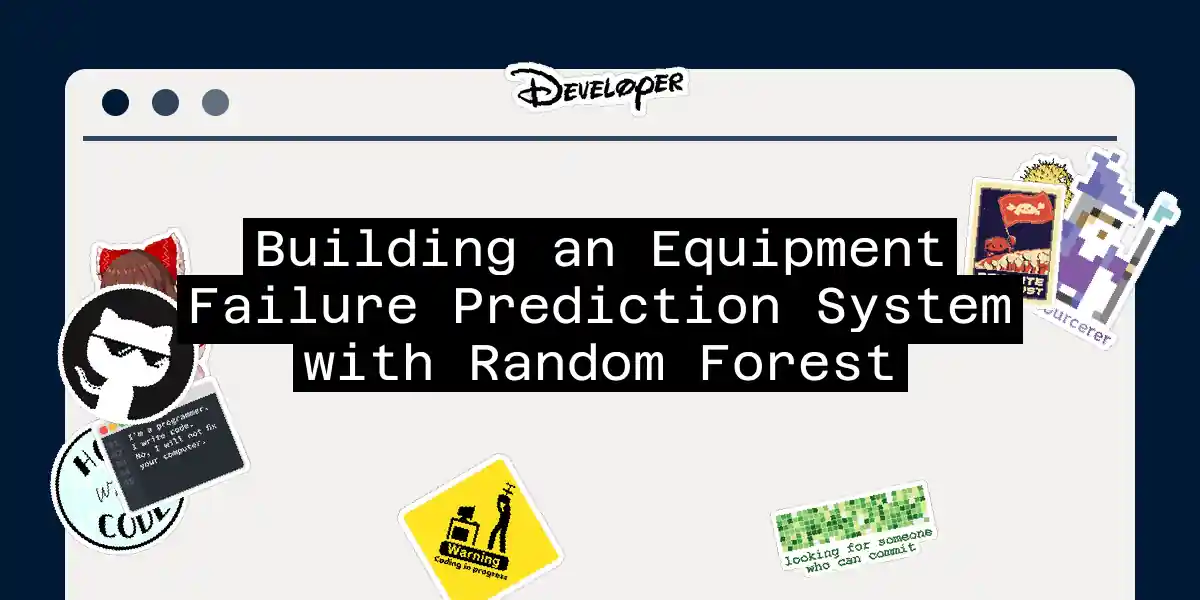Introduction to Predictive Maintenance
Predictive maintenance is the holy grail of industrial operations, allowing companies to anticipate and prevent equipment failures before they happen. This proactive approach not only saves time and money but also ensures smoother operations and higher productivity. One of the most powerful tools in the predictive maintenance arsenal is the Random Forest algorithm. In this article, we’ll delve into how to build a robust equipment failure prediction system using Random Forest, complete with step-by-step instructions and practical examples.
Why Random Forest?
Random Forest is an ensemble learning method that combines multiple decision trees to produce a more accurate and robust prediction model. Here are a few reasons why Random Forest stands out for predictive maintenance:
- Handling Complex Data: Random Forest can handle large, complex datasets with numerous variables, making it ideal for industrial settings where data from various sensors and devices is abundant.
- Mitigating Overfitting: By combining multiple decision trees, Random Forest reduces the risk of overfitting, which is a common issue in machine learning models.
- Feature Selection: Random Forest automatically selects the most important features from the dataset, which is crucial in identifying the key indicators of equipment failure.
Step-by-Step Guide to Building the System
1. Data Collection and Cleaning
The journey begins with collecting historical data on equipment failures. This data typically includes sensor readings such as temperature, pressure, vibration, and other relevant metrics.
Data cleaning is essential to ensure that the dataset is free from missing values and outliers. Here’s a simple example in Python using pandas to handle missing values:
import pandas as pd
# Load the dataset
data = pd.read_csv('equipment_data.csv')
# Check for missing values
print(data.isnull().sum())
# Fill missing values with mean or median
data['temperature'] = data['temperature'].fillna(data['temperature'].mean())
data['pressure'] = data['pressure'].fillna(data['pressure'].mean())
# Remove outliers
Q1 = data['temperature'].quantile(0.25)
Q3 = data['temperature'].quantile(0.75)
IQR = Q3 - Q1
data = data[~((data['temperature'] < (Q1 - 1.5 * IQR)) | (data['temperature'] > (Q3 + 1.5 * IQR)))]
2. Data Exploration and Feature Engineering
After cleaning the data, it’s time to explore it and identify patterns and trends. This phase is crucial for understanding the relationships between different variables.
Feature engineering involves creating new features that might be more informative for the model. For example, you might create a feature that represents the rate of change in temperature over time.
data['temp_rate_of_change'] = data['temperature'].diff() / data['time'].diff()
3. Model Training
Now it’s time to train the Random Forest model. Here’s how you can do it using scikit-learn in Python:
from sklearn.model_selection import train_test_split
from sklearn.ensemble import RandomForestClassifier
from sklearn.metrics import accuracy_score, confusion_matrix
# Split the data into training and testing sets
X = data.drop('failure', axis=1)
y = data['failure']
X_train, X_test, y_train, y_test = train_test_split(X, y, test_size=0.2, random_state=42)
# Train the Random Forest model
model = RandomForestClassifier(n_estimators=100, random_state=42)
model.fit(X_train, y_train)
# Predict on the test set
y_pred = model.predict(X_test)
# Evaluate the model
accuracy = accuracy_score(y_test, y_pred)
print(f"Accuracy: {accuracy:.2f}")
print(confusion_matrix(y_test, y_pred))
4. Model Evaluation and Deployment
After training the model, it’s essential to evaluate its performance using metrics like accuracy, precision, recall, and the confusion matrix.
For deployment, you can integrate the model into your existing system architecture to generate real-time predictions. Here’s a simple example of how you might set up an alert system:
import schedule
import time
def predict_and_alert():
# Load new data
new_data = pd.read_csv('new_data.csv')
# Make predictions
new_predictions = model.predict(new_data)
# Check for failures
if new_predictions == 1:
print("Equipment failure predicted. Alerting technician.")
# Send alert to technician
schedule.every(1).hours.do(predict_and_alert) # Run every hour
while True:
schedule.run_pending()
time.sleep(1)
System Architecture
The system architecture for predictive maintenance typically includes several components:
- Industrial Machines: These are the devices that generate the data.
- Data Storage: This could be a cloud-based solution or an on-premise database.
- Model Development: This is where the Random Forest model is trained and deployed.
- User Interface: This is where the predictions are displayed, and alerts are triggered.
Conclusion
Building a predictive maintenance system using Random Forest is a powerful way to anticipate and prevent equipment failures. By following the steps outlined above, you can create a robust system that not only saves costs but also ensures smoother operations. Remember, predictive maintenance is not just about predicting failures; it’s about creating a proactive culture that values efficiency and reliability.
So, the next time your equipment starts acting up, don’t just call the repairman; call the data scientist. Because in the world of predictive maintenance, data is the new oil, and Random Forest is the drill that uncovers it.
